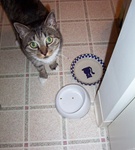How Much Food Should I Feed My Cat?
Some general rules to help you determine how much to feed your cat.

Here’s my cat waiting to be fed.

Hill's Science Diet's recommended daily feeding guide for its Adult Original dry food for cats between 1-6 years old.

Find out the type and flavor of pet food that your cat prefers and try to stick with them.
If you are new cat owner, you may be wondering how much food you should be feeding your cat each day. The amount of food your cat needs will vary depending on its age, weight, physical activity, metabolic rate and whether it's pregnant or not. Since every cat is different, you should tailor the amount of food it's given on your cats own individual needs. Here are some general rules you can follow.
- In general, cats tend to be overfed and under-exercised, so if you're unsure about the correct amount to give your cat initially, it's a good idea to start with less food. However, if your a new cat owner and your cat is constantly meowing for food, make sure that it gets enough food to put the cat at ease. A cat that is thrust into a new environment, may become nervous and want more food than it would typically. Once your new cat becomes comfortable with its new surroundings, which may take anywhere from 1 to 6 months you should start reducing the amount of food it gets to normal levels.
- Check the product label on the cat food you buy for the pet food makers recommended guidelines on how much to give your cat.
- Try to feed your cat wet and dry food each day. Split up the meals by giving your cat dry food in the morning and wet cat food at night. A cat might not eat all of its food in one sitting, so by giving your cat dry food in the morning, your cat will be able to nibble on whatever he doesn't eat during the day. As long as your cat does not gain excessive weight, leaving dry food out all day is not a problem. This should be avoided with wet food, because of the spoilage factor. Wet cat food will help your cat avoid constipation, which can lead to a cat pooping/peeing outside of it's litter box.
- In general, an Adult cat that weighs between 5-10 lbs should have between 2 to 4 oz (¼ to ½ cup) of dry food, or 5 to 9 oz of canned food per day. Kittens, senior adult and pregnant cats will typically require more food than these amounts.
- Feed your cat Premium pet food whenever possible. Premium foods contain higher quality ingredients and will provide your cat with better overall nutrients that make for a healthier cat. If you're cat is regularly throwing up after feeding, change your cat's cat food, as more than likely your cat is allergic to the food (in this case avoid Purina Cat Chow, Purina One, and Friskies). Recommeded cat food for a cat who throws up include: Purina Pro Plan FOCUS Adult Sensitive Skin & Stomach Herring & Rice Formula Dry Cat Food, Blue Buffalo BLUE for Cats Adult Dry Cat Food Sensitive Stomach, Purina Pro Plan Entrees in Gravy Adult Wet Cat Food and Hill's Science Diet Adult Sensitive Stomach & Skin Cat Food
- Avoid feeding your cat table scraps. Feeding table scraps can disrupt the balance of your cat's diet, which can lead to obesity. It may also encourage your cat to beg for food, or even to stop eating its own pet food and want to eat human food only.
- Try to establish a specific feeding schedule, so your cat will know when to expect its next meal. Most often this schedule will be based around your work or school schedule. Because of this, it usually makes sense to feed your cat once in the morning, and once when you get home from work or school.
- Lastly, always provide fresh water for your cat. Make sure you do not allow your cat to drink from unsanitary sources of water, such as the toilet bowl or a fish tank.
In general, most adult cats weigh between 6 and 14 pounds, so if your cat weighs much more than this you should consider putting it on a diet. To get an accurate measurement of your cat's weight you should take it to a veterinarian and have them weight it. However, to quickly determine your cat's weight using your bathroom scale, try the following. Step on your scale and weigh yourself while holding onto your cat, then weigh yourself without your cat. Now subtract the difference and you will get your cat’s approximate weight.
Foods that you should not feed your cat include: dog food, raw fish, raw eggs, large amounts of tuna or liver, chocolate, and any bones. You should avoid feeding your cat people food from your own meals. Also, while most cats like drinking milk and it is a nutritious snack, you should only offer it to your cat after it has eaten its solid food. You should also be aware that a surprising number of cats are lactose intolerant, and milk will often cause them to develop diarrhea if they drink too much. So if you suspect that milk is causing your cat to have an upset stomach, then you should avoid giving it milk or any other types of dairy products.